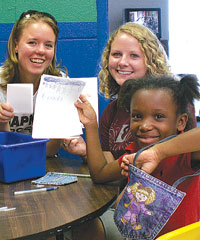NCAA News Archive - 2006
« back to 2006 | Back to NCAA News Archive Index
|
The NCAA News
DALLAS — The NCAA Divisions I, II and III Student-Athlete Advisory Committees discussed the use of male practice players in female sports and the posting of personal information on popular online social networks during their July 13-17 meetings.
The student-athlete groups also conducted separate sessions to discuss division-specific issues.
Division I SAAC members supported the use of male practice players as long as enough restrictions are in place to protect participation opportunities for women. The SAAC has actively sought feedback on the long-debated issue.
"Many female student-athletes feel that male practice players are beneficial," said Division I SAAC Chair Mike Piscetelli, a former track and field student-athlete at Wake Forest University. "They claim that the male players make them play harder in practice and raise the level of skill because of the overall intensity."
Division III SAAC members agreed with their Division I counterparts, also recommending that male practice players be permitted, but only with restrictions.
"We want the criteria to address how many practice players are allowed and how often they’re used," said Division III Chair Sameer Khan, a former golf student-athlete at Fairleigh Dickinson University, Florham. "Our biggest concern is that we don’t take opportunities away from female student-athletes who are currently on the team, either in game situations or in practice."
Division III committee members pointed out that if male practice players are viewed as a benefit in women’s sports, male student-athletes don’t have the same opportunity to compete against bigger and stronger players in practice. SAAC members thought that created an inequitable situation and was another argument against unrestricted use.
In addition to male practice players, the committees also discussed the proliferation of Internet sites such as Facebook and acknowledged that student-athletes need to be aware of what they put online.
"We’ve been talking about Facebook since our November meeting," Piscetelli said. "It can be a great way to keep in touch with people, but you have to be aware that what you post is public knowledge and you’re representing your family, team and coach. It’s about more than just you."
The committees discussed campuses that have curbed student-athlete use of Facebook and agreed that they were opposed to such restriction.
"The reaction the institution takes and the reaction the athletics department takes need to be differentiated," Khan said. "If student-athletes are committing violations of the university’s code of conduct, that needs to be addressed by the institution, not the athletics department. Student-athletes shouldn’t be restricted if the entire student body isn’t restricted."
Khan agreed with Piscetelli in that Facebook and other online networks can be harmless — even positive — communication outlets, but that student-athletes need to be more aware of the ramifications of their actions.
"If you take a picture with a beer in your hand, you have to understand how the picture will look to everyone else who sees it," Khan said.
Community service
The committees also paused from their meeting agenda to continue their commitment to community service, spending time at the Boys and Girls Club of West Dallas. The outreach is a long-standing tradition during SAAC meetings, and projects typically involve working with area children.
At the Boys and Girls Club, SAAC members played basketball, ping pong, foosball, tag, dominoes and other games with the children. The student-athletes also participated in arts and crafts and taught swimming lessons. SAAC members also helped organize a room within the club to create more space for the children to play.
The three committees also noted the continuing success of the Division II SAAC’s involvement with the Make-A-Wish Foundation. In its third year of fund-raising, the Division II SAAC exceeded its goal of $100,000, collecting more than $114,000 to benefit children with life-threatening medical conditions (see story, page 11).
"We were really excited about that total and we’re going to continue with the project," said Division II SAAC Chair Megan Burd, a softball student-athlete at Wheeling Jesuit University. "We’ll be able to make a significant impact and grant several wishes."
Burd recognized the contributions that came from Division II student-athletes on campuses across the country, mentioning some creative projects that raised significant dollars, including a campus that had a babysitting night for $1 per child, with all funds going to Make-A-Wish.
Other highlights
Divisions I, II and III Student-Athlete Advisory Committees
July 13-17/Dallas
- The Division III SAAC supported an initiative that will fund a two-year drug testing pilot and education program (see story on page 1). The committee was concerned that the use of performance-enhancing drugs is more prevalent at the Division III level than the data suggest. "More and more student-athletes are getting away with using drugs during the offseason and preseason," said Division III SAAC Chair Sameer Khan. "By the time an opportunity comes to get tested, it’s long out of their system." The SAAC believes more frequent testing would be beneficial, but it recommended that the pilot be conducted without penalties to most accurately gauge the situation. The committee also recommended that an educational initiative about performance-enhancing and street drugs accompany the pilot program.
© 2010 The National Collegiate Athletic Association
Terms and Conditions | Privacy Policy

